Ex-Servicemen: A Reservoir of Trained and Experienced Human Resource
There are approximately 60,000 personnel released annually from the three services. Age-wise availability of skilled manpower is as under:
.
Existing Utilisation of Ex-Servicemen (ESM)
At present, the Ex-servicemen11 are being employed in the following manner:
- Reservation In Central Government Jobs (10 per cent in Gp ‘C’ Posts, 4.5 per cent for Disabled & Widows, 20 per cent in Gp ‘D’ Posts, 10 per cent Posts up to Asst Commandant in Central Paramilitary Forces (CPMF); 100 per cent in DSC and Public Sector Units and Nationalised Banks, 14.5 per cent in Gp ‘C’ posts and 24.5 per cent in Gp ‘D’ posts.
- Priority in government jobs for group ‘A’ and ‘B’.
- Jobs in Corporate and Private Sector.
- Lateral absorption in Central Paramilitary forces (CPMF).
- Self employment schemes.
Dynamics of Ex-servicemen
Employing ex-servicemen will be more economical for the government, as compared to fresh recruitment…
Ensuring full utilisation of its resources, particularly the ex-servicemen (till the age of 60) will result in optimal exploitation of the talent and capabilities of this trained and disciplined force towards the overall growth of the country, resulting in an inclusive growth as per the vision of our political leaders. Utilisation of the services of our ex-soldiers has multiple advantages, under which, firstly, it will exponentially raise the morale of Indian soldiers, secondly, both the private and public sectors can benefit by absorbing a skilled and disciplined workforce and thirdly, employing ex-servicemen is more economical for the government, as compared to fresh recruitment as they are paid only the difference between the entitled emoluments of the job and the pension being drawn by them.
The community involvement in rural development will result in better decision making, more durable actions, promotion of concept of self help, community development and empowerment and better capacity building. With the leadership crisis in the villages, it is time that the potent workforce of our ex-servicemen (Junior Commissioned Officers (JCOs)/ Jawans) be incorporated into the mainstream development projects, or rather they should take on the mantle to ensure comprehensive growth of the rural areas, with help from the society as well as from the government.
About 80 per cent of the ex-servicemen of the rank of JCOs and Non Commissioned Officers (NCOs) post retirement are settled in the villages. Investments incurred in the specialised training of the ex-servicemen, while in service, should not be allowed to go waste or be under utilised. It requires some time and money to make a man culturally rich to enable him to understand the importance of perseverance, discipline, sincerity to work and honesty in one’s dealings. Therefore, the training acquired in the Army, both technical and moral, should not be allowed to go waste, but optimised towards progressively creating ‘smart villages’ in the entire country.
Satyendra Kishore in his potency of ex-servicemen12 states the following:
India should take a clue from the tax credit mechanism that was available in the US for employers who hired veterans (ex-servicemen)…
- The country has 22.5 lakh defence pensioners and the number increases by about 60,000 each year and less than 50 per cent are being engaged in the growth story of this great nation.
- Government Sector (Central Armed Police Force (CAPF)/Ministries/Departments/Banks/PSUs) should be the largest employer, however less than 20 per cent jobs earmarked for the ESM are actually getting utilised.
- Only nine states (including UTs) provide any sort of reservation for the gazetted posts. The experience of the mid and high ranking officers of the armed forces is not optimised in execution and implementation of the vision of the nation, which must be recognised by the government.
- The bulk of reservation is in Gp ‘C’ and ‘D’, whereas Gp ‘D’ category has been abolished with effect from the Sixth Pay Commission.
- There is no ‘central data bank’ on the number of personnel superannuating, their capabilities/ expertise and corresponding link with the industry so as to ensure automatic absorption, as also follow the dictum of ‘Right man for the right job’.
- Neither is there any instrumentation of policy on the subject matter, nor any direction from the Government of India to ensure lateral absorption and seamless integration of this pool of talented, laborious and disciplined workforce.
- It can be observed that the above problems are primarily because there is no existing law/ bill/ act like ESM Empowerment Legislation and ESM Empowerment Act existing, which formalizes the involvement of ESM in the nation building and to include them both towards the national policies and programmes execution, as well as governance levels. There is therefore, the need to get a bill passed in the Parliament, which could address this critical issue.
Impetus By The Government
It can be observed, even after creation of SOSAS and RAPID structures, only limited number of ex-servicemen can be purposefully utilised, hence additional initiatives from the government would be required as follows:
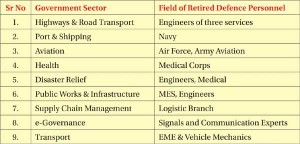 • Employment in Government Sectors: Exploiting the technical expertise and capabilities of the retiring personnel of the armed forces by employing them in the following government sectors:
• Employment in Government Sectors: Exploiting the technical expertise and capabilities of the retiring personnel of the armed forces by employing them in the following government sectors:
• Employment with Ministry of Defence (MoD): The MoD is a major employer of the civilian workforce. Absorption of ex-servicemen in such organisations will increase overall synergy, reduce defence expenditure and increase the satisfaction levels of the ex-servicemen.
Ex-Servicemen are present across the length and breadth of the country…
• Tax Concessions to India Inc.: India should take a clue from the tax credit mechanism that was available in the US for employers who hired veterans (ex-servicemen).13 For a corporate employer in the US, the tax credit can be as high as $9,660 for every qualified veteran hired. A similar model could be adopted by the Finance Ministry to provide tax concessions to companies that hire retired or ex-servicemen based on their skill requirements.
• Self-employment Schemes: The Department of Ex-Servicemen’s Welfare offers a host of self-employment schemes, but the demand which exists is far more than the availability. The government needs to create a climate which brings together industry as the franchisor, ex-serviceman as the franchisee and MoD as the facilitator, with the ultimate aim of forging a win-win partnership, which unambiguously boosts the national economy.
• Raising of Environmental Battalions: The ‘Swach Bharat Abhiyan’ and ‘Ganga Rejuvenation Plan’ are today national missions which can be best implemented by raising the environment battalions, staffed and manned by the ex-Servicemen from the eco-battalions.
• Exploiting pan-India presence: Ex-Servicemen are present across the length and breadth of the country. They are, therefore, the best candidates when it comes to pan-India requirements. With the government planning to construct the SEZs and associated infrastructure in terms of highways to connect these, there exists a scope to have a Welcom-Spot at every 50 or 100 km which are hubs for refreshment, refueling, repair, ATM services, where the ex-Servicemen provide the nucleus of the staff. This is an example of just one of the many such opportunities that exist.
India needs to pursue its national interest and address all visualised challenges with a well-measured, multi-pronged growth strategy…
Conclusion
In her quest to become a regional/ global power, India needs to pursue its national interest and address all visualised challenges with a well-measured, multi-pronged growth strategy. A nation can only achieve a holistic growth, if it addresses two issues; one, in terms of all sectors or segments which need to be brought into the folds of vibrant economy; and two, in terms of enabling sections of the population, whom the growth process has bypassed, to fully engage themselves with the development process. All those involved in the development of the Indian economy, banks, cooperatives, development finance institutions, NGOs and administrators, will have to rethink their own strategies in response to the new emphasis being given on holistic growth.
Ex-servicemen are ‘role models’ of ethical leadership with ingrained morals and value systems focused on ‘Duty, Honour and Country’ contributing to society and nation building in substantial proportion with a great sense of commitment towards multi-faceted progression and excellence in all spheres of activities. Perhaps the first step in this direction is to identify the cardinal segment of the rural economy, which has so far not attracted adequate attraction of the policymakers but which deserves focus in the new government strategy.
Notes
- Jumani USha, Empowering Society: An Analysis of Business, Government and Social Development Approaches to Empowerment, New Delhi, Foundation Books, 2006, pp. 3-13.
- United Nations, Human Development Report, New York, 2004, p.103.
- Mark Turner and David Hulme, Governance, Administration and Development, London, MacMillan Press, 1997, p. 24.
- Schinder Harmut, ‘Participatory Governance for Poverty Reduction’, Journal of International Development, 1999, pp. 221-234.
- Kotlyar I and Karakowsky L., ‘Falling Over Ourselves to Follow the Leader’, Journal of Leadership & Organisational studies, Vol. 14, 2007, pp. 38-47.
- Priyankan Goswami, ‘Indian Democracy, Where Anna Hazare Failed’, Times of Assam, December 13, 2011.
- Hirway Indira and Amrita Shah, Growth or Development: Which way Gujarat is going? OUP, New Delhi, 2014.
- Dalal Clayton and Bass D. B., Sustainable Development Strategies: A Resource Book, Earthscan Canada, 2002, pp-78-80.
- ibid, pp.85-92.
- Economic Times, Business Standard, April 20, 2014.
- Ministry of Defence, Directorate General Resettlement, New Delhi, May 2015.
- Satyendra Kishore, Re-Settlement of Ex-Servicemen in India, Problems, Patterns and Prospects, Concept Publishing Company, New Delhi, 1991, pp.22-26.
- Kably Lubna, ‘Tax Breaks to Hire an Army of Veterans’, Economic Times, September 8, 2014.




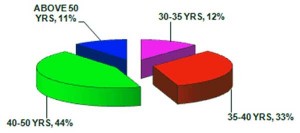
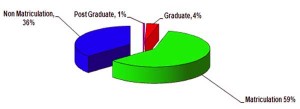
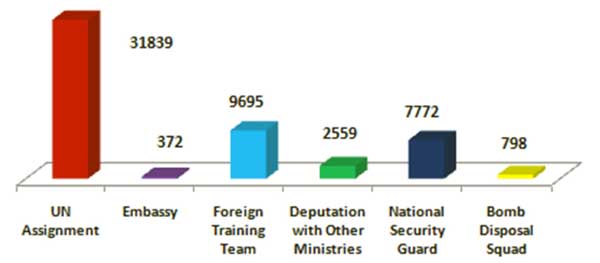

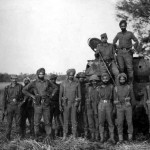
Good article written by serving officers. This article is good for academic purpose. It solves academic interest. Practically speaking, no concrete suggestion given. Present challenges and it’s solution not highlighted. Author should have gone into details of ex servicemen’s role in the nation building by visiting success stories and large number of ex servicemen re settled in urban and rural areas in India and neighborhood.